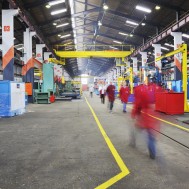There are currently 12.3 million manufacturing workers in the United States, accounting for 9 percent of the workforce. However, what manufacturing has become today has not always been the case.
Let’s take a look at how far manufacturing has come over the years.
From tedious labor to automation.
Manufacturing was once made up of long, tedious processes. The workforce had limited education, hardened skillsets and fluctuating pay rates. Employees worked in difficult, hazardous, environments for long hours. Due to the unsteady and off-putting conditions, the industry saw a decline in employment interest.
Now, automation and technology advances continue to change the manufacturing industry for the better. By 2018, around 1.3 million industrial robots will enter service in factories around the world.
This era of Industry 4.0 features the production-side equivalent of the consumer-oriented Internet of Things where everyday objects such as cars, watches and toasters are connected to the internet.
One of the most beneficial parts of automation is the idea of service-oriented design. For example, the communication between smart products and the smart machines manufacturing them allows the monitoring of product use to determine when they will give out. And the process is not just limited to phones and electronics — everything from custom-fit clothing to custom shampoos and soaps are at the consumer’s disposal.
From mass quantity to high quality customization.
Back in 1909, Henry Ford’s business model worked: customers went for low-cost, mass-production products rather than more expensive products fit exactly to their unique needs. Today, however, the rules have changed.
Today, customers want products tailored to their specific needs. According to the Smart Customization Group at MIT, 15 percent of clothing that Americans buy will be customized for fit, color and style by 2020. And clothing isn’t the only product to fit this category.
Among the most innovative and customized production techniques is 3D printing—a subset of additive manufacturing. In some cases, 3-D printed parts take less time to produce and often reduce costs. This mass customization model allows for several benefits:
- Satisfaction due to customer focus and shortened delivery times
- High efficiency
- Increased innovation and new product development
From limited skillsets to critical thinking.
Manufacturing workers possess extremely different skillsets than decades ago — mainly because these new skillsets are required for IT and technology positions.
Eighty percent of the fastest-growing occupations in the United States depend on mastery of Science, Technology, Engineering and Mathematics (STEM) fields. Manufacturing workers are not those with limited skillsets, they are machinists. Programmers. Engineers. Critical thinkers.
Today’s technology advances have created new types of manufacturing jobs that require more technical ability and critical thinking from employees who operate computer driven equipment, processes and environments. These are well-paid positions that need to be filled across the industry. This new, innovative workplace welcomes both millennials and the existing skilled workforce as manufacturers look to fill the skills gap.
From outsourcing to reshoring.
While manufacturing companies have a myriad of reasons for outsourcing production (increased flexibility, eliminating overhead costs, etc.), the landscape is changing – reshoring is beginning to bring manufacturing back home.
Over the past 25 years, U.S.-manufactured goods exports have quadrupled. In 1990, for example, U.S. manufacturers exported $329.5 billion in goods. By 2014, that number reached an all-time high, for the fifth consecutive year, of $1.403 trillion. This allows the following:
- More American jobs
- Safer products, since the U.S. Food and Drug Administration are held to higher quality requirements than foreign competitors
- Higher standards than foreign countries including safety working conditions and child labor laws
- Environmental benefits through less gas, emissions and resources
According to Reshoring Initiative, reshoring has helped restore close to 30 percent of the more than 850,000 post-recession jobs created in the U.S. manufacturing sector. A survey of U.S. manufacturers by Boston Consulting Group (BCG) also found that 54 percent are considering relocating production to the United States from China. Now, American workers produce 10-12 times the output of their Chinese counterparts.
Even for commodity parts like O-Rings, with advanced manufacturing, Apple Rubber can produce higher quality parts at cost competitiveness compared to our offshore counterparts. We believe in providing our customers the confidence of a quality and consistent product from first submission to long run production volumes.
How have you seen your manufacturing organization change over the years? Where do you see our industry headed in the future? Connect with us on Twitter @AppleRubber.
